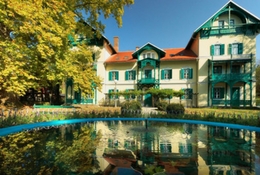The Republic of Slovenia lies at the heart of Europe, where the Alps and the Mediterranean meet the Pannonian plains and the mysterious Karst. To the north is Austria; to the east, Hungary; to the south, Croatia; and to the west, Italy. Slovenia is situated at the crossroads of central Europe, the Mediterranean, and the Balkans.
The Alps–including the Julian Alps, the Kamnik-Savinja Alps, the Karavanke chain, and the Pohorje Massif–dominate northern Slovenia near Austria. Slovenia’s Adriatic coastline extends for approximately 48 kilometers (30 mi.) from Italy to Croatia. The term “karst”–a limestone region of underground rivers, sinkholes, and caves–originated in Slovenia’s Karst plateau between Ljubljana and the Italian border.
On the Pannonian plain to the east and northeast, toward the Croatian and Hungarian borders, the landscape is essentially flat. However, the majority of Slovenian terrain is hilly or mountainous, with around 90% of the surface 200 meters or more above sea level.

Slovenia became an independent state in 1991 and a member of the EU on May 1, 2004.
It lies right in the middle of one of the world’s most exciting business regions. It sits at the intersection of several of Europe’s historical crossroads. Transport by rail and road prevails over air traffic due to Slovenia’s short distances. And Slovenia also has direct access to the sea through the Port of Koper. Ships coming into the Mediterranean through the Suez Canal can save 5-10 days and up to 3,700 km by using the southern sea-route access to Central Europe.
Area of Slovenia
Area: 20,273 square kilometers (7,906 sq. mi.) slightly smaller than New Jersey.
Cities: Capital–Ljubljana (2009 pop. 278,314). Other cities–Maribor (112,642), Kranj (54,562), Koper (51,915), Celje (48,993).
Tourism is a significant source of foreign currency, accounting for US$1.22 billion in revenue in 1996, a record for independent Slovenia, but still far behind the results before 1991, when many more foreign tourists visited its famous mountain resorts (around Lake Bled) and coastal areas. The authorities have been somewhat slow in recognizing the earning potential of that sector.
Even now, opinions are divided on this activity whose fortunes depend sometimes on circumstances beyond the country’s control. More recently the view has prevailed that tourism deserves more support, given the potential in a country combining an Alpine setting and a Mediterranean coast within a short distance, as well as numerous places of historical and architectural interest and broadly acclaimed health spas located in resort towns along the coast.
The financial crises that evolved into a global economic meltdown have overturned Slovenia’s traditionally strong scorecard in unemployment and the number of students enrolled in higher education programmes. At end-2009, the two figures are in the 100,000 bracket. The regions with more unemployed provide an attractive labor base as they end reliance on the traditional industries.
